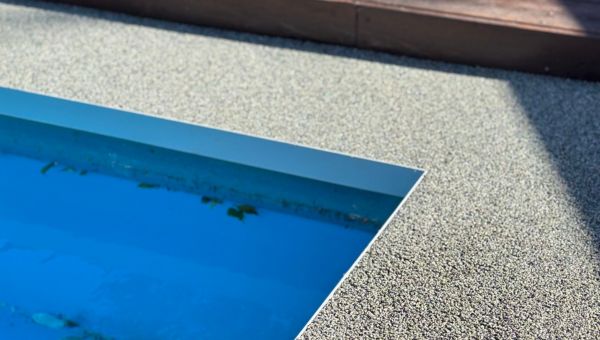Imagine basking in the warm sun while sipping the cool breeze as you unwind by your sparkling pool, taking time to appreciate what lies below your feet as this incredible view unfolds.
Your pool's surface serves much more than simply as a foundation; it serves to paint an outdoor paradise of its own! Not only beautiful in itself, but it also serves to maintain safety as well as impact the overall aesthetic and function of your swimming oasis. Pool surround and pool surround option we have to know about it.
This guide will take you on an exploration of all of the materials surrounding pools, each offering different combinations of durability, aesthetics, and functionality. We'll cover every option to enable informed choices - let's find your perfect materials match today! You get the idea about pool surround, and pool surround options, and compare pool deck surfaces.
Factors to Consider:
Safety First: Slip resistance is of critical importance both to personal and visitor safety, with slippery surfaces creating particular risks in areas frequented by seniors and children alike. Materials featuring increased slip resistance will decrease the possibility of accidents occurring thereby providing peace of mind to both you and your visitors.
Durability: Your pool is constantly exposed to harsh elements like water, chemicals and weather; therefore it is crucial that its material can withstand these forces without cracking under foot traffic or becoming damaged over time. Selecting durable material ensures minimal upkeep costs over time so you can enjoy years of long-lasting fun!
Your enjoyment of a pool depends heavily upon its ease of maintenance and cleaning. By choosing materials resistant to mold and mildew, you'll spend less time cleaning - giving more time for restful swimming sessions! Additionally, durability needs must also be addressed, along with any sealing or refinishing needs necessary for protecting both structural integrity and aesthetic appearance.
Aesthetics: When selecting materials to build your pool area, aesthetics play a pivotal role. Look for natural stone or tile finishes as these add rustic charm - creating an enjoyable pool experience for you and all who use the area.
Budget: To achieve quality and durability at the same time, finding materials that satisfy both affordability and performance must be balanced carefully. Select materials that achieve both goals by finding cost-effective options that meet both criteria.
Top Surface Materials for Pool Surrounds:
Concrete:
Versatile and customizable, offering various finishes such as stamped, stained or exposed aggregate finishes to meet different client preferences and traffic demands. Offers durable surface suitable for heavy foot traffic.
Pavers require sealing to enhance longevity, but may become crack-prone over time in areas with rapid temperature fluctuation. They are available in either concrete or stone materials and come in an assortment of colors, shapes, and patterns that complement any aesthetic. While individual units can easily be replaced when damaged, which reduces maintenance costs significantly. Re-leveling may occasionally be needed due to settlement; joints between pavers may collect dust if left neglected for too long. Natural Stone: Benefits: Exuding timeless elegance with classic options like travertine, limestone, and slate that provide classic sophistication in any pool environment and naturally providing slip resistance. Plus it naturally reduces slipperiness. Carpet requires regular sealing to avoid staining and has more upfront cost compared to alternative materials, while its weight makes installation a more complex endeavor.
Contrast this with tile which boasts endless style by being available in numerous colors, designs, sizes, and moisture-resistant ceramic or porcelain tiles that create an easy-to-keep surface while looking stylish at the same time. Grout installation and upkeep are both essential in order to prevent water infiltration and degradation, yet without adequate sealing or upkeep they could become discolored over time. Rubber: Rubber is a soft and forgiving surface ideal for pool areas used by children or used as water play zones while offering exceptional slip resistance with low maintenance needs. Wood decking may not meet everyone's aesthetic tastes and is susceptible to fading and degradation from prolonged sun exposure and harsh chemicals, creating an inviting and cozy ambiance perfect for above-ground pools. Creates an intimate setting.
While hardwood flooring provides natural beauty and customization to any space it inhabits, regular sealing and maintenance to protect it against warping, splintering, discoloration caused by moisture exposure or UV rays and even possible rot require regular attention and may need replacing in some instances.
Case Studies:
Climate Consideration: Concrete may be more vulnerable to cracking in regions experiencing extreme temperature variations compared to pavers or natural stone surfaces like pavers and rubber mats; usage patterns including pool areas popular among children could benefit from its soft yet slip-resistant surface; more elegant settings might prefer natural stone's elegance instead, with maintenance routines including grout maintenance to avoid water damage as well as paver leveling due to gradual settlement over time. Pool surround and pool surround option you get knowledge now
Maintenance Tips for Pool Surrounds:
Regular Cleaning: To keep the surrounding of your pool area looking its best and to prevent slipperiness and slip hazards from developing, routinely sweep, hose down surfaces with clean water, and occasionally use a pressure washer to clear away dirt, algae or buildup with regular sweeping of debris, hosing down and pressure washing is required to keep things looking pristine and avoid slipperiness or buildup that could create slip hazards in slippery conditions around it. Cleaning will maintain both appearance and prevent slipperiness hazards that might otherwise arise and create slip hazards which increase its safety as well. Regular maintenance also maintains appearance while helping prevent slip hazards by maintaining its overall appearance within its surroundings - helping keep everything looking spotlessly beautiful all around your poolside!
Sealing and Resealing: Always referring to manufacturer recommendations when sealing porous materials such as concrete, stone, and wood can extend durability and stain resistance, adding lasting beauty. Sealing will extend its lifespan as well as preserve aesthetic value of pool surrounds over time.
Repairing Damage:
As soon as a crack, chip, or loose tile appears it should be repaired immediately to reduce further deterioration and ensure safety for everyone using your pool surround. Prompt action will prevent larger issues arising later and preserve its integrity for as long as possible.
Prep Your Pool Area for Winter:
Before winter hits, drain and cover your pool area properly so as to protect it against freeze-thaw damage and costly repairs incurred from harsh temperatures. By doing so, winterizing will leave it ready to be enjoyed when warmer months return!
Conclusion: choosing a surface material for your pool surround is an integral factor that affects its safety, durability and aesthetic appeal. By taking into consideration factors like slip resistance, maintenance requirements aesthetics and budgetary restrictions before making an informed choice that enhances your pool experience.
Regular maintenance for your pool surround, such as cleaning, sealing and repairing damage as well as winter preparations is vital to increase its lifespan and remain safe and visually pleasing over the years ahead. By investing in high quality materials as well as following proper care protocols for maintenance practices you can create an outdoor oasis which reflects both your personality and provides endless enjoyment for family and friends alike.
Before selecting a surface material for your pool surround, take some time to assess your individual needs, budget and preferences. Concrete offers versatility; natural stone provides elegance; while wooden decking adds warmth. Selecting an ideal material will result in creating an outdoor living space that complements both lifestyles.




